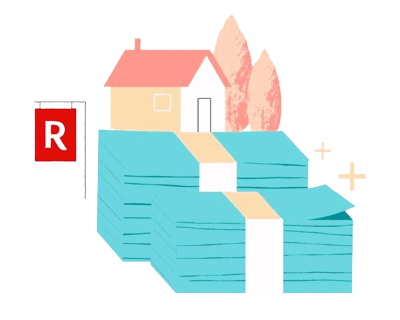
Owning a home—whether it’s a cozy house in Seattle , a townhouse in NYC , or a charming home in Nashville —is a dream for many. With recent drops in mortgage rates , now might be the perfect time to turn that dream into reality. However, the process of buying a home can feel overwhelming, especially for first-time home buyers . This home buying checklist is designed to simplify your journey, guiding you through each step to help you confidently achieve homeownership.

1. Know how much house you can afford
Determining how much house you can afford is the first step in the home buying checklist. Setting a realistic budget will relieve stress in the long run and help narrow your home search. Here are the steps to determine how much house you can afford:
First, calculate your debt to income ratio (DTI) . This is your monthly expenses versus your cash intake, or the bills you pay divided by your gross monthly income. Debts include recurring bills, such as car payments, daycare expenses, and student loans. Most lenders require your DTI to be no higher than 43%.
Be sure to build some breathing room into your budget, so you have money to spend on activities you enjoy and any emergencies that may arise.
The safest rule of thumb dictates that your mortgage loan payment should not exceed 28% of your monthly gross earnings. Your lender will use this number as an initial benchmark in their calculations to determine the loan amount for which you may qualify.
Here’s an example:
Let’s say your monthly gross income is $8,000. Multiply $8,000 by 28, which equals $224,000. Then, divide that by 100, resulting in $2,224. According to the 28% rule, this is the maximum monthly mortgage payment you could afford, including principal, interest, taxes, home insurance (PITI), and mortgage insurance.
If you can pay 20% of a home’s purchase price as a down payment, you’ll likely secure a lower interest rate, potentially saving you thousands over time.You’ll also find that your monthly mortgage payments are smaller because you owe less on the house.
A 20% down payment also eliminates the extra monthly payment for private mortgage insurance(PMI). PMI is a type of insurance often required if you make a down payment of less than 20% of the home’s purchase price. PMI is added to yourmortgage payment to protect the lender—not you—if you stop making payments on your loan.
One of the most helpful tips to save for a down payment is to set a budget and stick to it. Calculate your net income, track your spending, set realistic goals, use the 50/30/20 rule , and adjust your spending to stay on budget.
Depending on your situation, there are loans with much lower down payment options, ranging from 3.5% to 10%. Veterans may even qualify for a VA loan , which requires no down payment. Regardless of your circumstances, it’s wise to start saving for your down payment. . Make sure to see if you’re eligible for down payment assistance programs that can help reduce the amount of money you put down on a house.



The third step in the home buying checklist is improving your credit score. Yes, it is still possible to buy a house with bad credit . However, the type of loan you’ll qualify for – and at what interest rate – will depend on your credit score. Lenders use your FICO score, a number between 300 and 850, to determine your creditworthiness for a mortgage. To get a conventional loan, you’ll need a score of at least 620. However, scores over 760 will earn you the best rates and terms.
Your lender can guide you on which debts to pay down first and which credit lines to keep open to improve your credit. “You’ll want to avoid doing anything that could affect your credit score or your debt-to-income ratio, which measures your total debts against your monthly income. ,” states Ashwin Dayal of Orchard Mortgage . “Opening new lines of credit, such as a car loan or store credit cards, could potentially delay your closing process.”
The money-saving tips in step two of the home buying checklist can also boost your credit score. If you spot errors on your credit report affecting your rating, consider a credit repair company to help fix the issues.
For more tips on improving your financial standing, check out this helpful Redfin article on boosting your credit score quickly . It’s a great guide to help you get closer to your homeownership goals. You can read it.
2. Find a real estate agent you trust
A real estate agent will be with you every step during the home buying process and will offer expert knowledge of the local housing market . They can advise on whether a home is listed at a fair asking price, what to make of the home inspection, assist in the negotiation process, and explain the paperwork involved in the closing process.
Find a real estate agent who listens to you, understands your goals and needs for buying a house, and has the resources to help you succeed. Ask your friends and family for referrals to an agent they’ve worked with and felt did an excellent job representing their interests. If you’re moving to a new area, look at online reviews and see who you think would be best to represent your interests and who will take the time you need to find your perfect house.
Be sure you are comfortable with the person you choose – the home buying process can be stressful, and having an expert by your side who has your best interest in mind is imperative. They’ll guide you through many of the later steps in the home buying checklist.
Different lenders – banks, credit unions, and mortgage companies – all offer different mortgage loan options. It’s critical to research and shop around to get the best possible deal, so do your research and ask questions before deciding on the lender to finance your purchase. Here’s more about mortgage companies and what to look for, in their own words:
Once you have selected a lender you want to use and before you start looking at homes, get a mortgage pre-approval . A pre-approval includes a maximum loan amount and puts the agent in a position to negotiate with confidence on your behalf. It also strengthens your offer to the seller because a bank is already willing to lend you the money, improving the likelihood of closing the sale. This is an essential step in the home buying checklist.
Explore different neighborhoods and locations to get a feel for whether you would like to live there. Maybe you’re moving from Downtown Portland to rent an apartment in Chicago . Or perhaps you’re renting a house in Fort Worth, TX , and interested in relocating. By understanding your preferred areas early on, you’ll be better positioned to find a home that meets your criteria in a location you love.
Look for local amenities and services that support your lifestyle, such as a school, hospital, grocery, other retail shopping, a gas station, or public transit. Drive around at different times to see what’s happening in the neighborhood. Check it out during the week, on weekends, and during the day and evening.

Once you have zeroed in on a neighborhood or area you like, figure out what the perfect home for you looks like. Do you love Mid-Century Modern-style houses or prefer Victorian-style houses ? Are you looking for a single-family home or a condo? Front porch or back deck? The options are endless.
You’ll also want to decide how many bedrooms and bathrooms you prefer and the overall square footage of your ideal home. Don’t worry about every nook and cranny of the home, but understand that an average two-bedroom home in the U.S. is between 1,600-1,800 square feet. A “small” house is less than 1,000 square feet. While a “large” house comes in at 3,000 or more square feet.
Now that you’ve set your search criteria and started looking for a home, you’ll want to make a list of your “required” and “nice-to-have” home features before you begin your home tours. Your real estate agent can help you narrow your search by using multiple listing services (MLS) results.
Arguably the most enjoyable step in the home buying checklist is attending open houses and home tours. Watch the ads for open houses and start visiting the homes that fit your criteria. If they are in your chosen location, that’s ideal but not essential. Open houses outside of your desired location can be considered test houses, which will at least give you an idea of what’s on the market in your price range.
You can also attend virtual home tours if you don’t have the time to make it out to a house you want to look at or if you are moving cross-state or cross-country, for example. Video tours can help you identify the type of home you like, the layout you want, and the features you like or don’t want in your home.
If you’re pre-approved and find the right home during one of your home tours, you’re ready to make an offer. Your real estate agent will help decide how much to offer on a particular home, complete the offer letter , and ensure you’ve included all the important details in your offer – timing, exclusions, contingencies, etc. Your agent sends your offer to the seller’s real estate agent, who decides if they agree with your offer price and terms. This usually requires the home buyer to include an earnest money deposit that will be put into escrow, typically 1-3% of the purchase price. Once your offer is accepted, this money will be applied to the mortgage closing costs and down payment.
An offer below the asking price might be rejected in more competitive markets. However, in a slow market, home buyers might have a chance to offer below the asking price and get their offer accepted.
During the negotiations phase of this home buying checklist, an excellent real estate agent demonstrates real value to help buyers and sellers strike a deal. Your real estate agent can help you determine what to include in the offer. They can also help guide how you should respond to a counter-offer when the seller didn’t agree to your first offer but didn’t reject it outright. They may counter some or all of the requests in your offer. You can determine whether you can go along with the counter-offer items and if you’ll counter back. For more tips on navigating negotiations, here’s a helpful article on how much you can negotiate on a house .

You’ll want to get an inspector to walk through the home to ensure there are no major repairs, system issues, or unforeseen costs and liabilities. They will check that the plumbing, electrical, and fixtures (like windows) are up to code and ensure there are no maintenance issues. Your lender may require all this to close the loan, and your agent can help you set it up.
“A home purchase is one of the largest single investments you will ever make,” says Vegas Valley Inspections . “You should know exactly what to expect — indoors and out — in terms of needed and future repairs and maintenance. An inspection will uncover hidden issues, such as structural problems or roof leaks, and offer a professional assessment of the property’s condition. This process helps you avoid unexpected surprises and gives you a clearer picture of what you’re buying, including positive aspects and necessary maintenance to keep the home in good shape.””
Nearly every home inspection reveals minor problems, at the very least. But, watch out for these red-flag items that come up in the home inspection, which come with varying but sometimes significant costs to repair or replace if you make an offer on the house:
Be fair, but factor in your anticipated repair and maintenance costs in the short term. You may not need everything in perfect condition if the house fits your criteria otherwise, but you want to understand your risk of significant expenses in the near future.
“Typically, the appraiser will walk through the property to observe its physical characteristics and condition, making notes of its features and amenities,” shares R. Scott Dugan of Dugan Appraisals in Las Vegas, NV . “The appraiser will compare the subject property’s characteristics to recent sales of similar homes in the same area, adjusting for significant differences between the subject property and those sales. The next step is reviewing the data and reconciling the adjusted sales into a single-point value opinion for the subject property. Depending upon the property type (urban location, luxury quality, rural location, etc.), the appraisal can take several days to several weeks.”
Your lender will send in a home appraiser to determine if the home’s value is equal to or less than what you offered to pay. Several factors may be at play here, but the offer and appraised value should be close for your lender to finalize your home loan. Every lender differs in their specific criteria.
If your home inspector or the appraiser finds fault in the home, you may want to renegotiate your purchase offer. Your real estate agent can help you with this process, which allows you to adjust your offer in light of the findings or cancel the offer altogether. On the original offer, these items are often called contingencies .
In some states like New York, a real estate attorney is required. However, even if it’s not required where you live, if you are not using a title company to finalize the purchase, it’s in your best interest to hire a real estate attorney . A real estate attorney will review your offer and all related documents, like the inspection and appraisal. They’re equipped to know the answer to legal questions that may arise and will ensure you didn’t overlook anything in the contract and that all the agreements you and the seller made are fulfilled.
Trust us, having peace of mind with one of your life’s biggest purchases will be worth the extra expense of hiring an attorney.

“One of the first major milestones in the home buying process after your process is accepted is when a title company conducts a title search, or an examination of public records, to underwrite a title insurance policy and produce a title report,” shares Wyatt Millar of Doma , an innovative platform for a better closing experience. “The title report confirms legal ownership and reveals any claims or liens on the property that must be resolved before transfer. Lenders also require title insurance for both purchase and refinance transactions.”
Tip: Always review the title report carefully and ask your title company to clarify any issues or claims found during the search. This can help prevent unexpected surprises and ensure a smooth closing process.
You’ve made it – the big day is here. Purchase agreements are signed, inspections are complete, contingencies are met, and your lender has approved funding your loan. Now, you will exchange money and the deed will now transfer from the seller to you. Closing can take place in person or online through a secure portal. The deed gets recorded at the county courthouse, and you are now the property’s owner. A title company or a real estate attorney can close and record the transaction.
“During the closing process, a title company helps a homebuyer secure legal ownership of a property and manage the secure distribution of funds,” states Qualia Labs , a cloud-based title, escrow, and closing platform. “Depending on the state, the company’s responsibilities may include checking the property title and issuing title insurance, managing the movement of money, preparing closing documents, and overseeing the closing to ensure the transaction goes smoothly..”
There are many moving parts to consider when you’re looking to buy a house. When you understand the basics, you’ll be in a good position to assess your credit, apply for a loan, and successfully navigate the actual house purchase. The trip to homeownership may seem daunting, but with this home buying checklist, you’ll be in control and be a homeowner in no time.
If you are represented by an agent, this is not a solicitation of your business. This article is for informational purposes only, and is not a substitute for professional advice from a medical provider, licensed attorney, financial advisor, or tax professional. Consumers should independently verify any agency or service mentioned will meet their needs. Learn more about our Editorial Guidelines here .
If you are represented by an agent, this is not a solicitation of your business. This article is for informational purposes only, and is not a substitute for professional advice from a medical provider, licensed attorney, financial advisor, or tax professional. Consumers should independently verify any agency or service mentioned will meet their needs. Learn more about our Editorial Guidelines here.

Holly is part of the content marketing team and enjoys writing about home improvement and lifestyle. Her dream home would incorporate both an industrial and biophilic design.